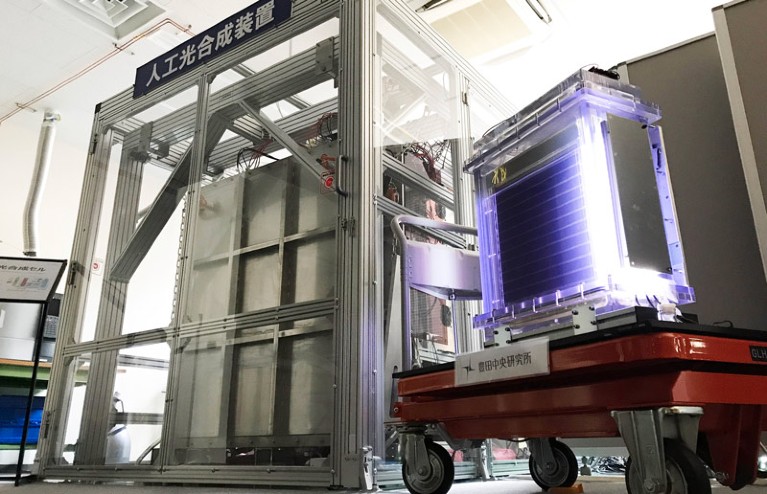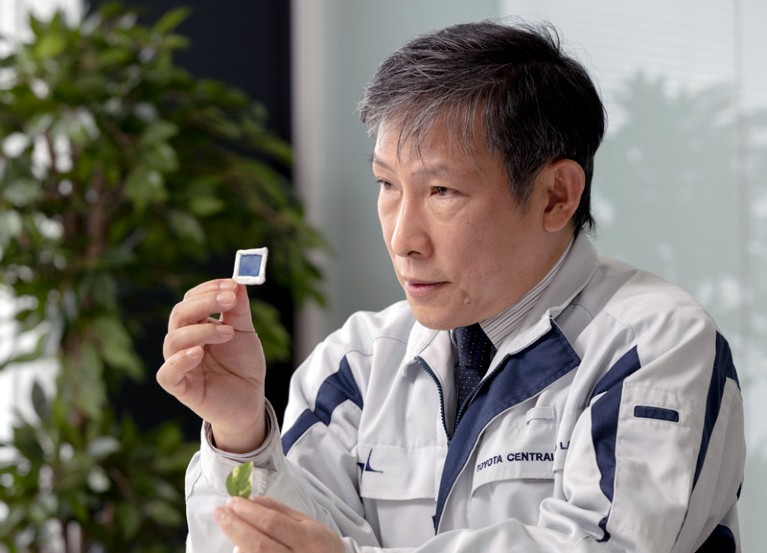
A cell with a solar-to-chemical conversion efficiency of 10.5% yields formate at a cost efficient production rate of 1.2 mole per hour.© Toyota Central R&D Labs., Inc.
In 2021, researchers from Toyota Central R&D Labs developed a large, cost-effective artificial photosynthesis system that produces industrial formate at a solar-to-chemical conversion efficiency (ηSTC) of 10.5%1. Researchers from the lab say that, to their knowlege, this ηSTC is a first for a one metre squared cell.
Within the next 10 years, the company aims to establish artificial photosynthesis technology for wide-scale production of useful carbon compounds.
Plant power
Artificial photosynthesis is an emerging technology, attracting interest for its potential to mimic plants by producing industrially useful compounds using CO2, water, and sunlight. But the technology is still in its infancy and is unavailable for use on an industrial scale.
This new system is based on the use of metal-complex catalysts to convert CO2 into carbon compounds at electrical potentials approaching the theoretical lowest limits for the conversion reactions.
The researchers used solar cells connected to electrodes immersed in carbonated water to initiate the redox reactions that produce formate, explains Naohiko Kato, a principal researcher at Toyota Central R&D Labs. This coupling of electrodes with semiconductors and molecular catalysts allowed for CO2 reduction to occur using minimal energy and relatively inexpensive components.
Advances at the lab have been quick. In March 2021, a 36 centimetre squared cell produced by the company was shown to have a ηSTC of 7.2%2. Then in November 2021, the group demonstrated a one metre squared cell with a ηSTC of 10.5%, yielding a formate production rate of 1.2 mole per hour.
Most importantly, Kato emphasizes that cost efficiency has reached the point of realistic discussion of real-world production. “We use inexpensive crystalline silicon solar cells,” he explains. “While other materials have superior conversion efficiency, the material expense makes the cost per watt extremely expensive.”
It’s hoped that this technology is also good for the environment, as it could use the concentrated CO2 industrial by-products. “Our artificial photosynthesis system now absorbs 100 times more CO2 compared to cedar forests of the same area,” notes Kato.

Naohiko Kato is a principal researcher at Toyota Central R&D Labs.© Toyota Central R&D Labs., Inc.
Inspiration from photocatalyst technology
In 2011, Toyota Central R&D Labs established a proof of principle for an artificial photosynthesis systems that produces carbon compounds from water, CO2 and sunlight, without any other additives3.
The system was small, measuring roughly one square centimetre. “The inspiration for this semiconductor/metal-complex catalyst assembly came from a semiconductor photocatalyst technology that we had been supplying to the market for 20 years for odour-eliminating, antibacterial, and antiviral purposes,” explains Takeshi Morikawa, a senior research fellow in Toyota Central R&D Labs.
“Artificial photosynthesis, however, is very challenging,” says Morikawa. Their first one square centimetre system used two photocatalysts immersed in water that, when exposed to sunlight, produced a ηSTC of 0.04%, only one fifth of the ηSTC demonstrated by a plant such as switchgrass. In 2015, however, continued improvements led to the ‘artificial leaf’, a one square centimetre electrode device that achieved a ηSTC of 4.6%, exceeding that of typical plants.

Takeshi Morikawa’s ‘artifical leaf’ has a solar-to-chemical conversion efficiency of 4.6%.© Toyota Central R&D Labs., Inc.
Interdisciplinary expertise
Kato’s team has been working on increasing the device size. “To make artificial photosynthesis practical in a real-world setting, the device must be large enough for scalable, industrial use,” says Kato, who joined the project after extensive experience working with solar cells.
“Maintaining high efficiency in larger sizes does not come easily. Simply expanding the size of all components would increase the reactive resistance of the electrodes,” he says. “In fact, the conversion efficiency dropped drastically in the initial phase. We had more reduction occuring with oxygen than with CO2, leading to an excess of hydrogen and decrease in the amount of formate produced.”
Leveraging the expertise of colleagues in materials and device engineering, they designed a new system that captures energy from the sun with solar cells in lieu of photocatalysts. “Solar cells are superior at converting sunlight to electrons,” explains Kato.
The team aspires to establish technology for an industrial system at a scale of one square metre by the 2030s. “The focus is to improve the system so that it captures and converts high-concentrate CO2 from industrial emissions,” says Kato.
Globally, 700,000 tonnes of formate are used annually, largely as a preservative in livestock feed and leather processing. It also shows potential as a hydrogen carrier for the new hydrogen economy, says Kato. While other promising liquid carriers, such as ammonia, must be kept at low temperatures (-34°C or above 0.1MPa at room temperature), formate is easier to manage as it maintains a liquid form in ambient conditions.
The production of other chemicals is also in the team’s sights. “This could be a platform for wider artificial photosynthesis,” says Morikawa. “It may be possible to use different catalysts that convert CO2 and water to other compounds — it’s a matter of how soon we can discover the catalysts.”


